
This document is draft and has not gone through the internal editorial review process.

Appendix C: High-Injury Network Methodology
Table of Contents
1. Developing the High-Injury Network
Step 2—Create a 1-Mile Sliding Window
Step 3—Create a 100-Foot Buffer
Step 4—Aggregate the Crash Scores
Step 5—Calculate Percentile Rankings
Regional HIN and Corridors of Concern
Subregional HINs and Corridors of Concern
Municipal HINs and Corridors of Concern
2. The High-Injury Network and PTI Populations
Comparing the HIN to PTI Populations
List of Tables
Table 1.2 | HIN Coverage by Subregion
Table 2.1 | Minority Populations and the HIN
Table 2.2 | Low-Income Populations and the HIN
Table 2.3 | Limited English Proficiency Populations and the HIN
Table 2.4 | Disabled Populations and the HIN
Table 2.5 | Youth Populations and the HIN
Table 2.6 | Elderly Populations and the HIN
List of Figures
Figure 1.1 | HIN Analysis Steps
Figure 1.5 | Quincy HIN and Corridors of Concern
Figure 1.6 | Revere HIN and Corridors of Concern
Figure 1.7 | Needham HIN and Corridors of Concern
Figure 1.8 | Bolton HIN and Corridors of Concern
Figure 1.9 | Somerville HIN and Corridors of Concern
Figure 2.1 | High-Injury Network in Relation to Low-Income, Minority, and L.E.P. Populations
Figure 2.2 | High-Injury Network in Relation to Disabled, Older, and Younger Populations
Figure 2.3 | High-Injury Network in Relation to U.S. DOT ETC’s Disadvantaged Population Indices
The Boston Region Metropolitan Planning Organization (Boston Region MPO) is developing a Vision Zero Action Plan supported by a grant from the federal Safe Streets and Roads for All (SS4A) Program. A key component in developing this plan is the creation of a High-Injury Network (HIN)—a series of roadway locations throughout the region on which a high proportion of traffic fatalities and serious injuries occur. This memorandum provides a description of the methodology for developing the HIN, the data and criteria used, and key findings from the HIN. The results of the HIN will provide priority locations for tailored treatments throughout the regional, subregional, and municipal transportation networks.
Development of the HIN requires two key forms of data: crash data and roadway data. For the Boston Region MPO HIN, crash data were obtained through the Massachusetts Department of Transportation (MassDOT) IMPACT Crash Data Portal. The data represent years 2018 to 2022.
MassDOT’s Roadway Inventory data were utilized as the spatial base for the HIN, segmenting the roadway every 0.1 miles. Limited-access roads were removed from the dataset, as the focus of this plan is primarily local roads and what the MPO and municipalities can do to address local roadway safety. Also, MassDOT has systems in place for addressing limited-access state-owned roads, and the higher traffic volumes and congested-related crashes would skew the HIN thresholds.
Crashes were assigned to the segments within 100 feet of the crash location. Limited-access roadways and ramps were then removed from the HIN, leaving only partial- and full-access roadways.
The HIN development is one of the main elements of the Vision Zero Action Plan. The purpose of the HIN is to locate roads where the crashes are highest both in terms of frequency and severity. To do so, an HIN sliding window analysis was conducted by using a 1-mile window to assess clusters of crashes along the roadway network at the level of Greater Boston Metro Region, the 97 municipalities in the region, and eight subregions: North Shore Task Force (NSTF), North Suburban Planning Council (NSPC), Minuteman Advisory Group on Interlocal Coordination (MAGIC), Inner Core Committee (ICC), MetroWest Regional Collaborative (MWRC), South Shore Coalition (SSC), Three Rivers Interlocal Council (TRIC) and South West Advisory Planning Committee (SWAP). Ranking the roadway segments was completed using a five-step process outlined in Figure 1.1. Each step is described in further detail below.
Figure 1.1 | HIN Analysis Steps
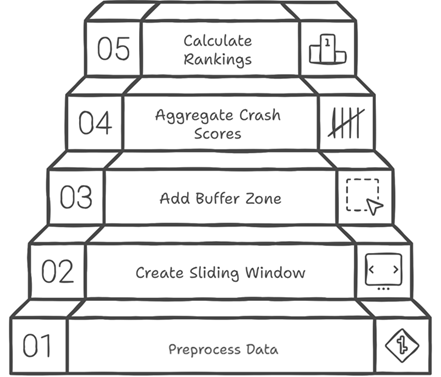
The first step in the HIN development is preprocessing the road layer and the crash layer. This includes reviewing the data for errors and anomalies, as well as formatting the data in a way that allows for connecting and joining in geographic information systems (GIS).
The MassDOT road layer was reviewed for any connectivity issues or inconsistencies. The following roadways were excluded from the analysis layer:
The crash data was obtained from the MassDOT IMPACT Crash Data Portal. Crashes that occurred on Interstates and ramps were removed to avoid attributing them to neighboring roadway facilities. The crash layers contain all the crash metadata including crash severity and whether the crash involves a vulnerable road user (VRU).
It should be noted that crash data within the City of Waltham show an overrepresentation of the fatal and serious injury crash categories that is not consistent with the previous years. This resulted in the municipality being overrepresented in both the regional and subregional HIN. To remain impartial towards the data, no adjustments have been made to balance the overrepresented fatal and serious injury crashes. Any efforts targeting or prioritizing projects in Waltham based on the regional or subregional HIN should consider this data quality concern when comparing the municipality’s roadways to neighboring municipalities.
In the second step, a 1-mile sliding window was created that slides at 0.1-mile increments along each road. This sliding window allows for a localized analysis of crash data, enabling a detailed examination of specific segments of the road network. The movement of the window ensures that all road segments are covered in the analysis and that the largest groupings of crashes are identified. For roads less than a mile in length, the entire road was treated as a single segment.
The third step involved creating a 100-foot buffer around each 1-mile window. This buffer is essential for capturing the crashes that can be attributed to the roadway segment, including those that were geolocated just outside the travel way. The team experimented with multiple buffer widths, and found a 100-foot buffer was best at addressing limited geolocation precision without attributing crashes to unrelated nearby segments.
In the fourth step, crash scores were aggregated within the created buffers. This aggregation process involved compiling data on crashes that occurred within the buffer. The aggregated scores were calculated based on equivalent property damage only (EPDO) crash cost scores. EPDO assigns a value for each crash based on the severity and the general cost of crashes classified under that severity, relative to property damage only crashes. Values for each crash within a given window/buffer are then added or aggregated together. The aggregation of EPDO scores provide valuable insights into the safety performance of each road segment by including both frequency and severity of crashes in a single metric. Table 1.1 provides the EPDO crash values used for the HIN.
Table 1.1 | HIN Crash Scoring
| KABCO Severity Category |
Non-VRU Crash Score |
VRU Crash Score |
|---|---|---|
Fatal Injury (K) |
15 |
22.5 |
Suspected Serious Injury (A) |
15 |
22.5 |
Suspected Minor Injury (B) |
2 |
3 |
Possible Injury (C) |
1 |
1.5 |
No Apparent Injury (O) |
0 |
0 |
The final step of the HIN process was to calculate the ranking of the sliding window segments based on the buffer scores. This ranking helps to identify which segments of the road network have seen a higher rate of costly crashes compared to others based on reactive analysis of crash data. The team decided to set the threshold at the top five percent of the roads/crash scores to constitute the HIN. The top five percentile scores were selected to minimize the percentage of roads, while maximizing the coverage of the crashes. About 65 percent of the region’s fatal and serious injury crashes occurred on the HIN.
The Boston Region MPO chose to distinguish between the corridors in the HIN, the severe crash hotspots, and the other corridors with high crash frequencies but lower crash severity. As such, the corridors with two (2) or fewer fatal and serious injury crashes were defined as “corridors of concern’ and eliminated from the main HIN.
The HIN was created using a five-step systematic approach to assess and prioritize road safety. The approach utilizes network screening best practices for HIN development. It is also unbiased and replicable.
Table 1.2 shows the coverage percentage of the HIN for each of the subregion’s fatal and serious injury crashes compared to the portion of roadway mileage in the subregion. The regional HIN provides substantial coverage of the region’s crashes.
Table 1.2 | HIN Coverage by Subregion
| Subregion |
HIN Coverage % |
Road Length % |
|---|---|---|
Inner Core Committee (ICC) |
67.5% |
8.7% |
Minuteman Advisory Group on Interlocal Coordination (MAGIC) |
64.4% |
6.9% |
MetroWest Regional Collaborative (MWRC) |
48.3% |
5.5% |
North Suburban Planning Council (NSPC) |
65.2% |
7.1% |
North Shore Task Force (NSTF) |
61.6% |
6.7% |
South Shore Coalition (SSC) |
67.7% |
7.3% |
South West Advisory Planning Committee (SWAP) |
64.5% |
6.7% |
Three Rivers Interlocal Council (TRIC) |
58.2% |
6.9% |
Boston Region MPO Regional Network |
65.1% |
6.9% |
The HIN coverage statistics provide a measure of how concentrated or dispersed the crashes are within a certain network. The highest coverage is 67.7 percent for the SSC subregion and 67.5 percent for the ICC subregion, which indicates the crashes are slightly more concentrated, consistent with more urban settings and congested roadways. The lowest coverage is 48.3 percent for the MWRC subregion, which shows that crashes are slightly more dispersed, consistent with the suburban/rural land use types where the network has less traffic and opportunities for conflicts and driver errors are more spread out.
The regional HIN (as shown in Figure 1.2) is heavily concentrated around the ICC subregion due to the heavy traffic, congestion and opportunities for crash conflicts in the subregion. This is also impacted by the multimodal nature of this network and higher pedestrian and bike activity. Most of the identified corridors within the regional HIN have two or more fatal and serious injury crashes, since fatal and serious injury crashes are weighted heavily in the EPDO calculation. Few corridors were labelled as corridors of concern or locations with high EPDO scores despite lower severe crash totals.
Figure 1.2 | Regional HIN
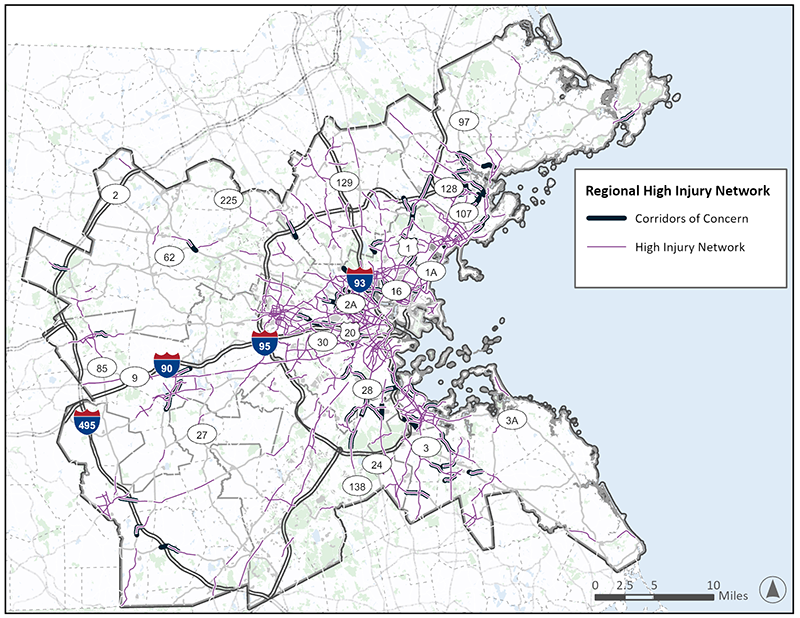
The subregional HINs (as shown in Figure 1.3) provide a clearer, more nuanced view of the roads that can be crash hotspots within each subregion. These are particularly useful to prioritize targeted safety investments when the projects are tied to geographies within the subregional boundaries. The subregional HINs have a higher percentage of corridors of concern identified than the Regional HIN. This is because the subregional HIN compares crash scores within each subregion, including some suburban/rural subregions that have much lower crash concentrations (and fatal and serious injury crash concentrations) than the ICC subregion.
Figure 1.3 | Subregional HIN

The 97 individual municipal HINs (shown in Figure 1.4) provide a prioritization tool for each municipality to explore its own roadways and crash hotspots. Smaller municipalities with fewer roads and lower traffic volumes do not appear as frequently on the regional or the subregional HINs, thus the municipal HIN provides a context-sensitive comparison of their network and local roads. Municipalities can also partner with neighboring municipalities to create stronger improvements along roadway segments that transcend town barriers. The municipal HINs have the most corridors of concern identified, to support locations with high EPDO values, even where more than two fatal or serious injury crashes were not observed.
Figure 1.4 | Municipal HINs
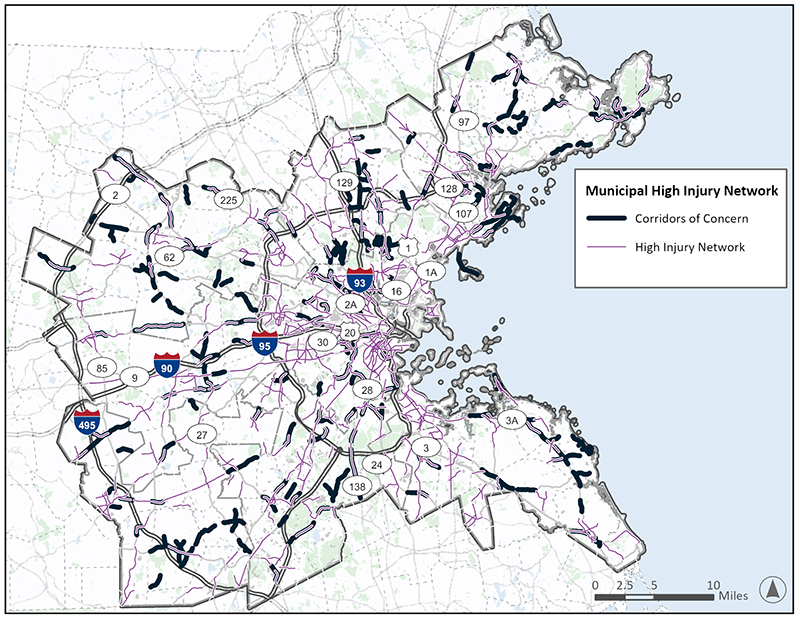
The following figures (Figure 1.5 through Figure 1.9) contain examples from five different municipalities that represent different land uses, ranging from heavily urban to rural contexts. The HIN for each of these municipalities provides prioritization of higher crash roadways within the municipalities and allows decision makers to prioritize these roadways for future safety improvements and funding.
Figure 1.5 | Quincy HIN and Corridors of Concern

Figure 1.6 | Revere HIN and Corridors of Concern
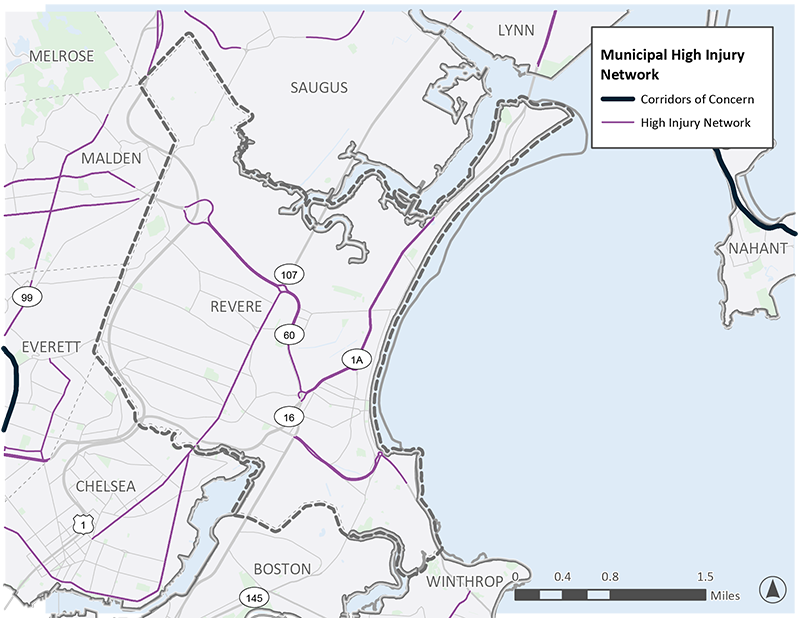
Figure 1.7 | Needham HIN and Corridors of Concern

Figure 1.8 | Bolton HIN and Corridors of Concern
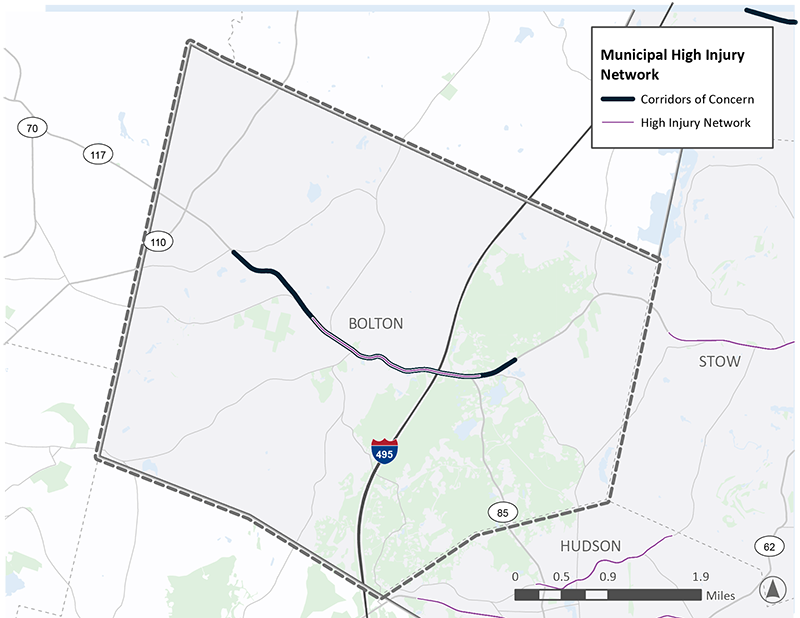
Figure 1.9 | Somerville HIN and Corridors of Concern

An objective of Task 2.4 was to identify what Priority Transportation Investment (PTI) communities and populations are disproportionally exposed to high crash roads, as defined by the High-Injury Network (HIN) (developed in Task 2.3). The analysis conducted under Task 2.4 informs the prioritization of high-injury network corridors for targeted safety investments (Task 5 of the development of the Boston Region Vision Zero Action Plan).
Findings from the Task 2.4 analyses suggest that areas with a higher share of low-income, minority, and/or limited-English proficiency (L.E.P.) individuals also have a greater share of roadway segments included in the HIN.
Findings indicate that roadways in areas with a higher share of low-income, minority, and/or L.E.P. populations (and to a lesser extent areas with a relatively higher share of individuals with a disability) consist of a greater share of the HIN relative to the area’s roadway miles.
Prioritization of safety investments in areas with a high share of minority, low-income, and L.E.P. populations would address the disproportionate number of crashes and support underserved communities.
The task objective was to identify communities that are disproportionally exposed to roadways with a high number of severe crashes. This task consisted of using GIS to compare the location of the HIN against the census tract demographics. Census tracts are a useful geography for this investigation as these areas tend to have the same boundary over the census years, generally an average population of about 4,000 people, and can be tied to various socio-demographic characteristics.
There are various ways to consider PTI populations in the process of understanding whether the HIN falls disproportionally in different communities. For an initial investigation, two existing sources that define PTI populations were used: one based on the MPO’s definition of PTI populations and one based on U.S. DOT’s definition. Both databases define areas associated with protected populations under civil rights laws and environmental justice directives.1 Other sources were considered (e.g., CDC/ATSDR Social Vulnerability Index), yet these were not applied in the examination of the HIN because these sources use the same underlying data sets (U.S. Census surveys) and would result in similar outcomes.
The Boston Region MPO provided a database of the region’s census tracts with the number and share of PTI populations associated with their definitions of (a) Low-income; (b) Minority; (c) limited English proficiency (L.E.P.); (d) Older Adults (age 75 or older); (e) Young People (age 17 and under); and (f) Disabled. In this database, a PTI area is defined as having a share of the PTI population that is higher than MPO region’s average for that PTI population.2
As described later in this memorandum, the project team explored variations of how to define a PTI area using the share of a PTI population and its percentile rank within the Boston Region.
As an alternative to the Boston Region MPO’s PTI database, two datasets from U.S. DOT (the Equitable Transportation Community [ETC] Social Vulnerability index and the ETC Transportation Insecurity index) were analyzed to understand these indices relative to the HIN. The ETC Explorer tool is “an interactive web application that uses 2020 Census Tracts and data, to explore the cumulative burden communities experience, as a result of underinvestment in transportation.” The use of the tool is intended to “help ensure the benefits of DOT’s investments are addressing the transportation related causes of disadvantage” and to “understand how [an area] is experiencing [a] burden that transportation investments can mitigate or reverse.”3 Furthermore, U.S. DOT states that the ETC Explorer “provides MPOs, State DOT’s, and local decision makers tools to help select projects that meet the transportation needs of areas, which in turn will help strengthen communities and create more opportunities to improve daily life.”
This database is also organized by census tract. The ETC’s Social Vulnerability index is a measure of 13 socioeconomic indicators “that have a direct impact on quality of life. This set of indicators measure lack of employment, educational attainment, poverty, housing tenure, access to broadband, and housing cost burden as well as identifying household characteristics such as age, disability status and English proficiency.” The Transportation Insecurity index is intended to represent “when people are unable to get to where they need to go to meet the needs of their daily life regularly, reliably, and safely.”4
As noted by the Boston Region MPO’s own geographical analyses of PTI populations in the Boston region, in general, minority populations, people with low incomes, and people with limited English proficiency tend to live closer to or in the city of Boston, whereas people age 75 years or older, people age 17 years or younger, and people with disabilities are dispersed throughout the region.5 By exploring the association of the geographic distribution and concentrations of PTI populations against the location of the HIN, it can be determined whether a greater share of the HIN falls within areas with high concentrations of PTI populations.
The project team performed two sets of screening analyses:
Figure 2.1 and Figure 2.2 show the comparison between the share of the HIN and the share of the entire roadway network that overlap with specific PTI populations. Situations where the HIN overlaps more with PTI populations compared to the entire roadway network indicate a stronger correlation between those PTI populations and high-injury crash areas.
Comparing the PTI populations with the HIN produce the following findings:
Figure 2.1 | High-Injury Network in Relation to Low-Income, Minority, and L.E.P. Populations
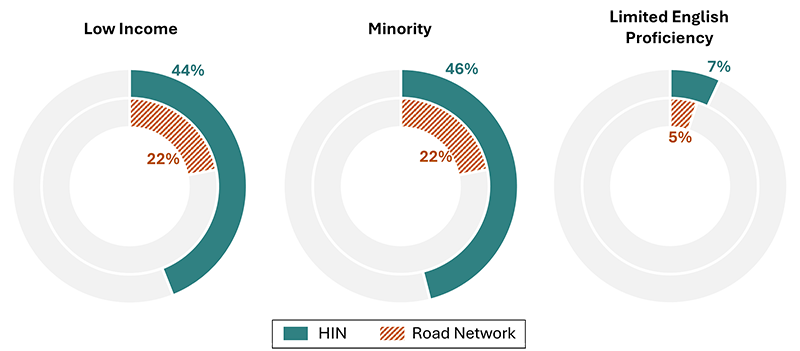
Figure 2.2 | High-Injury Network in Relation to Disabled, Older, and Younger Populations
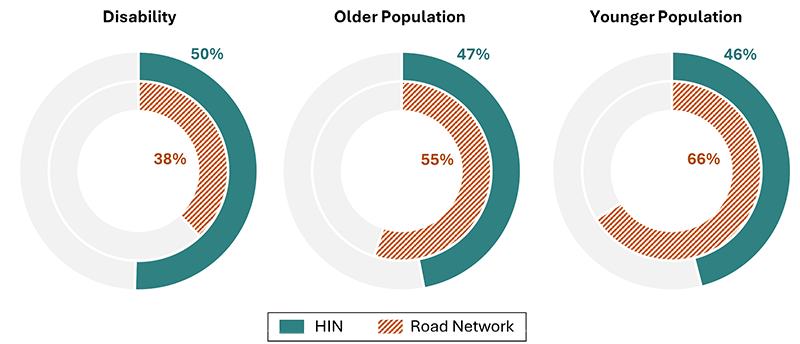
In addition to specific populations based on one PTI characteristic, the HIN can also be compared to more holistic PTI communities, such as:
Results of this comparison are seen in Figure 2.3. The Social Vulnerability Index is significantly over-represented (40 percent versus 20 percent) in the HIN and the Transportation Insecurity Index is not over-represented (33 percent versus 52 percent).
Figure 2.3 | High-Injury Network in Relation to U.S. DOT ETC’s Disadvantaged Population Indices
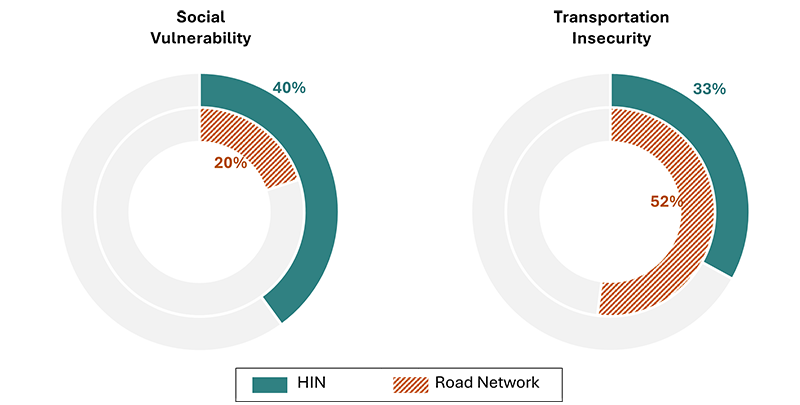
In reviewing the Boston Region MPO’s census tracts based on their percentile rank associated with the share of each PTI population, areas with a higher share of minority, low-income, L.E.P., and (to a lesser extent) disabled populations tend to have a higher share of the HIN relative to the area’s roadways:
Summary tables associated with this screening are provided below in Table 2.1 through Table 2.6.
Table 2.1 | Minority Populations and the HIN
| Quintile |
Population Totals |
Share of MPO Population |
Roadway Network |
|||||
|---|---|---|---|---|---|---|---|---|
| Minority Population |
Total Population |
% Minority |
Minority Population |
Total Population |
Share of MPO Road Miles |
Share of HIN Miles |
Ratio |
|
1 |
479,667 |
636,800 |
75.3% |
39.2% |
19.0% |
9.1% |
20.8% |
2.29 |
2 |
303,836 |
653,583 |
46.5% |
24.8% |
19.5% |
12.5% |
24.1% |
1.92 |
3 |
203,697 |
648,715 |
31.4% |
16.6% |
19.3% |
18.1% |
22.3% |
1.23 |
4 |
151,681 |
701,590 |
21.6% |
12.4% |
20.9% |
26.9% |
17.8% |
0.66 |
5 |
84,934 |
716,506 |
11.9% |
6.9% |
21.3% |
33.3% |
14.9% |
0.45 |
Total |
1,223,835 |
3,357,194 |
36.5% |
100.0% |
100.0% |
100.0% |
100.0% |
1.00 |
Source: U.S. Census Bureau; 2020 Decennial Census Demographic and Housing Characteristics and 2018–2022 American Community Survey.
Table 2.2 | Low-Income Populations and the HIN
| Quintile |
Population Totals |
Share of MPO Population |
Roadway Network |
|||||
|---|---|---|---|---|---|---|---|---|
| Low-Income Population |
Total Population |
% Low-Income |
Low-Income Population |
Total Population |
Share of MPO Road Miles |
Share of HIN Miles |
Ratio |
|
1 |
246,067 |
567,200 |
43.4% |
39.3% |
17.6% |
7.6% |
17.9% |
2.36 |
2 |
167,357 |
670,740 |
25.0% |
26.7% |
20.8% |
14.2% |
24.4% |
1.71 |
3 |
104,333 |
657,505 |
15.9% |
16.7% |
20.4% |
20.2% |
22.3% |
1.11 |
4 |
69,811 |
663,679 |
10.5% |
11.1% |
20.6% |
26.1% |
18.8% |
0.72 |
5 |
38,623 |
665,204 |
5.8% |
6.2% |
20.6% |
31.9% |
16.6% |
0.52 |
Total |
626,191 |
3,224,328 |
19.4% |
100.0% |
100.0% |
100.0% |
100.0% |
1.00 |
Source: U.S. Census Bureau; 2020 Decennial Census Demographic and Housing Characteristics and 2018–2022 American Community Survey.
Table 2.3 | Limited English Proficiency Populations and the HIN
| Quintile |
Population Totals |
Share of MPO Population |
Roadway Network |
|||||
|---|---|---|---|---|---|---|---|---|
| L.E.P. Population |
Total Population |
% L.E.P. |
L.E.P. Population |
Total Population |
Share of MPO Road Miles |
Share of HIN Miles |
Ratio |
|
1 |
186,181 |
618,628 |
30.1% |
51.3% |
19.6% |
9.3% |
21.3% |
2.29 |
2 |
87,253 |
607,668 |
14.4% |
24.1% |
19.2% |
13.6% |
22.1% |
1.63 |
3 |
50,126 |
647,910 |
7.7% |
13.8% |
20.5% |
20.3% |
22.1% |
1.09 |
4 |
29,300 |
684,477 |
4.3% |
8.1% |
21.7% |
25.7% |
19.6% |
0.76 |
5 |
9,819 |
602,423 |
1.6% |
2.7% |
19.1% |
31.2% |
14.9% |
0.48 |
Total |
362,679 |
3,161,106 |
11.5% |
100.0% |
100.1% |
100.1% |
100.0% |
1.00 |
Source: U.S. Census Bureau; 2020 Decennial Census Demographic and Housing Characteristics and 2018–2022 American Community Survey.
Table 2.4 | Disabled Populations and the HIN
| Quintile |
Population Totals |
Share of MPO Population |
Roadway Network |
|||||
|---|---|---|---|---|---|---|---|---|
| Disability Population |
Total Population |
% Disability |
Disability Population |
Total Population |
Share of MPO Road Miles |
Share of HIN Miles |
Ratio |
|
1 |
112,337 |
649,528 |
17.3% |
33.2% |
19.6% |
13.8% |
20.6% |
1.49 |
2 |
81,937 |
695,092 |
11.8% |
24.2% |
21.0% |
20.0% |
22.7% |
1.14 |
3 |
65,683 |
691,494 |
9.5% |
19.4% |
20.9% |
23.0% |
19.1% |
0.83 |
4 |
50,654 |
692,571 |
7.3% |
15.0% |
20.9% |
22.5% |
21.4% |
0.95 |
5 |
28,040 |
578,101 |
4.9% |
8.3% |
17.5% |
20.8% |
16.2% |
0.78 |
Total |
338,651 |
3,306,786 |
10.2% |
100.1% |
99.9% |
100.1% |
100.0% |
1.00 |
Source: U.S. Census Bureau; 2020 Decennial Census Demographic and Housing Characteristics and 2018–2022 American Community Survey.
Table 2.5 | Youth Populations and the HIN
| Quintile |
Population Totals |
Share of MPO Population |
Roadway Network |
|||||
|---|---|---|---|---|---|---|---|---|
| Youth Population |
Total Population |
% Youth |
Youth Population |
Total Population |
Share of MPO Road Miles |
Share of HIN Miles |
Ratio |
|
1 |
186,706 |
712,149 |
26.2% |
29.4% |
21.2% |
26.4% |
15.7% |
0.59 |
2 |
166,983 |
761,759 |
21.9% |
26.3% |
22.7% |
27.1% |
18.9% |
0.70 |
3 |
139,170 |
729,136 |
19.1% |
21.9% |
21.7% |
22.5% |
24.8% |
1.10 |
4 |
95,942 |
611,031 |
15.7% |
15.1% |
18.2% |
16.3% |
25.5% |
1.56 |
5 |
45,685 |
543,119 |
8.4% |
7.2% |
16.2% |
7.7% |
15.2% |
1.97 |
Total |
634,486 |
3,357,194 |
18.9% |
99.9% |
100.0% |
100.0% |
100.1% |
1.00 |
Source: U.S. Census Bureau; 2020 Decennial Census Demographic and Housing Characteristics and 2018–2022 American Community Survey.
Table 2.6 | Elderly Populations and the HIN
| Quintile |
Population Totals |
Share of MPO Population |
Roadway Network |
|||||
|---|---|---|---|---|---|---|---|---|
| Elderly Population |
Total Population |
% Elderly |
Elderly Population |
Total Population |
Share of MPO Road Miles |
Share of HIN Miles |
Ratio |
|
1 |
81,653 |
695,863 |
11.7% |
34.8% |
20.7% |
27.6% |
23.3% |
0.84 |
2 |
57,914 |
732,123 |
7.9% |
24.7% |
21.8% |
26.2% |
20.9% |
0.80 |
3 |
46,133 |
724,762 |
6.4% |
19.6% |
21.6% |
23.1% |
20.4% |
0.88 |
4 |
32,957 |
661,890 |
5.0% |
14.0% |
19.7% |
14.9% |
18.3% |
1.23 |
5 |
16,157 |
542,556 |
3.0% |
6.9% |
16.2% |
8.3% |
17.1% |
2.06 |
Total |
234,814 |
3,357,194 |
7.0% |
100.0% |
100.0% |
100.1% |
100.0% |
1.00 |
Source: U.S. Census Bureau; 2020 Decennial Census Demographic and Housing Characteristics and 2018–2022 American Community Survey.
The project team performed a correlation analysis to further assess the relationship between the PTI population percentile ranks and the percentage of roads within the census tract that are on the HIN. Through this correlation analysis, the team can identify which PTI groups show higher exposure to the HIN. These identified groups can be prioritized because of their higher correlation with roadways designated as high injury within their census tracts.
The analysis involved the following steps:
The analysis identified that the primary PTI populations that correlate with a higher proportion of the HIN in relation to the road network are “Minority,” “Low-Income,” “L.E.P.,” and “Disability.” Notably, “Youth Population” and “Elderly Population” were found to have a negative correlation with the percentage of HIN roads. These findings generally align with the conclusions from the refined screening analysis that investigated the PTI populations by quintile group.
More detailed results from the analysis are shown in Table 2.7.
Table 2.7 | Correlations between Share of Transportation PTI Population and HIN Proportion of Area Roadways
Community |
Minority Share |
L.E.P. |
Youth |
Elderly |
Disability Share |
Low-Income Share |
HIN |
Minority Share |
1 |
0.78 |
0.035 |
-0.48 |
0.27 |
0.65 |
0.42 |
L.E.P. Share |
0.78 |
1 |
-0.00022 |
-0.28 |
0.39 |
0.68 |
0.35 |
Youth Share |
0.035 |
-0.00022 |
1 |
0.092 |
0.015 |
-0.19 |
-0.24 |
Elderly Share |
-0.48 |
-0.28 |
0.092 |
1 |
0.17 |
-0.35 |
-0.21 |
Disability Share |
0.27 |
0.39 |
0.015 |
0.17 |
1 |
0.46 |
0.084 |
Low-Income Share |
0.65 |
0.68 |
-0.19 |
-0.35 |
0.46 |
1 |
0.37 |
HIN Proportion |
0.42 |
0.35 |
-0.24 |
-0.21 |
0.084 |
0.37 |
1 |
The project team performed a refined analysis to confirm the initial findings, further identify the HIN relative to PTI populations, and point to which PTI populations could factor in the prioritization of the HIN for safety investments. The screening uses characteristics tied to the census tract level. Tracts are compared against each other according to their percentile rank of the characteristic among the Boston Region MPO’s geography.
1 Environmental Justice (EJ) at the Federal Highway Administration (FHWA) means identifying and addressing disproportionately high and adverse effects of the agency’s programs, policies, and activities on minority populations and low-income populations to achieve a fair distribution of benefits and burdens. Similarly, the Federal Transit Administration’s EJ Circular 4703.1, issued August 2015, further directs MPOs to identify and address disproportionately high and adverse effects (referred to as disproportionate burdens) of its activities on minority populations and low-income populations.
2 The U.S. Census Bureau data sources for these demographic characteristics include:
3 U.S. DOT ETC Explorer, Homepage: https://experience.arcgis.com/experience/0920984aa80a4362b8778d779b090723/page/Homepage/. Note: As of May 2025, this page has been taken down by U.S. DOT.
4 U.S. DOT ETC Explorer, Understanding the Data: https://experience.arcgis.com/experience/0920984aa80a4362b8778d779b090723/page/Understanding-the-Data/. Note: As of May 2025, this page has been taken down by U.S. DOT.
5 Transportation Improvement Program (TIP): Federal Fiscal Years 2024–28, Geographical Analyses of Populations in the Boston Region, www.ctps.org/data/pdf/plans/TIP/FFYs-2024-2028-TIP.pdf#page=335.